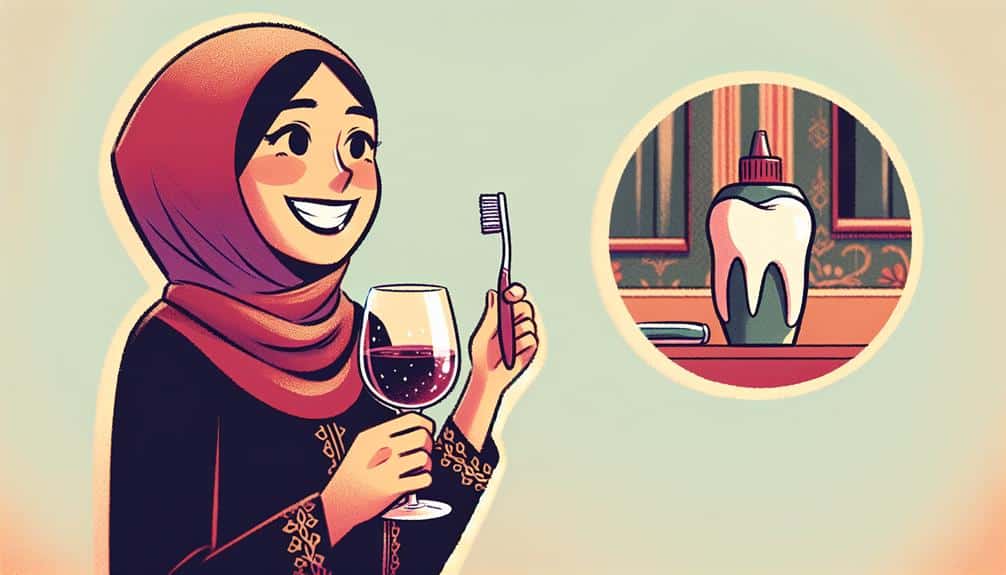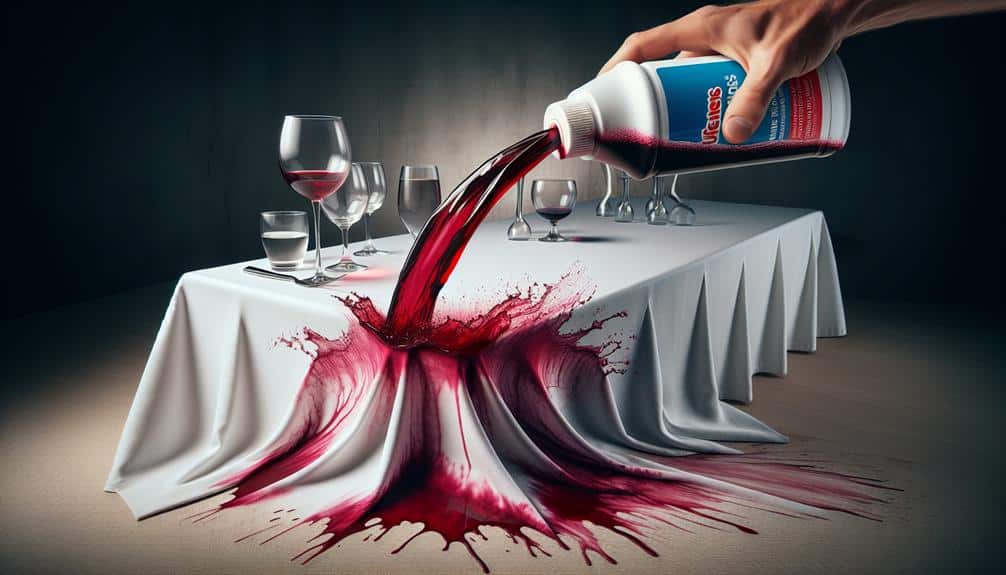Combat wine stains on teeth by creating a paste of baking soda and water to scrub away surface discoloration. Mixing lemon juice with baking soda can help lighten stains effectively. Proceed with caution as acidic remedies may harm enamel. For more stubborn stains, professional whitening options like trays or laser treatments can provide noticeable results. Additionally, natural remedies such as apple cider vinegar can be sparingly used to combat stains. Maintain a bright smile by incorporating daily oral hygiene practices. Discover more tips to keep your teeth sparkling and stain-free.
Key Points
- Brush teeth promptly after consuming wine to prevent stains.
- Rinse mouth with water to remove wine pigments.
- Use whitening toothpaste to combat surface discoloration.
- Consider professional whitening treatments for persistent stains.
- Avoid excessive use of acidic DIY remedies to protect enamel.
Types of Wine Stains on Teeth
When red wine or white wine comes into contact with your teeth, they can leave behind stains that vary in intensity and appearance. Red wine discoloration is a common issue caused by chromogens, tannins, and acids present in the wine. Chromogens are pigmented compounds that can stick to the enamel, while tannins can make it easier for these compounds to adhere to your teeth. The acidic nature of red wine can also weaken the enamel, making it more susceptible to staining.
On the other hand, white wine enamel can be affected differently. Despite being less pigmented than red wine, white wine is more acidic, which can erode the enamel and make it more prone to staining from other food and drinks. Understanding how red and white wines interact with your teeth can help you take preventive measures to minimize staining and maintain a bright smile.
DIY Whitening Paste Recipes
To combat wine stains on your teeth, consider trying DIY whitening paste recipes that can help restore your smile's brightness and minimize discoloration caused by red and white wine. One popular method involves creating a baking soda remedy. Baking soda, known for its mild abrasive properties, can help scrub away surface stains on teeth. To make a simple paste, mix a small amount of baking soda with water to form a paste-like consistency. Gently brush this mixture onto your teeth, focusing on areas where wine stains are prominent, and rinse thoroughly.
Another DIY whitening paste recipe utilizes a lemon juice mixture. Lemon juice contains citric acid, which may help lighten stains on the teeth. However, using this mixture sparingly is crucial as the acidity of lemon juice can potentially erode tooth enamel over time. To create this paste, combine a small amount of lemon juice with baking soda to form a paste. Apply this mixture to your teeth for a few minutes, then rinse thoroughly. Remember, moderation is key when using acidic substances on your teeth to prevent damage.
Professional Whitening Options
Consider exploring professional whitening options to achieve a more immediate and effective solution for removing stubborn wine stains from your teeth. When DIY remedies fall short, professional treatments can offer a more intensive approach to tackle deep stains.
Here are three common professional whitening options to contemplate:
- Whitening Trays: Custom-made trays filled with a whitening solution that fit over your teeth. These trays guarantee the whitening agent is evenly distributed, providing consistent results.
- Laser Treatment: In-office procedures that involve the use of a laser to enhance the whitening process. The laser activates the whitening agent, accelerating the treatment and potentially yielding quicker results.
- Professional Consultation: Before deciding on a specific treatment, consult with a dental professional. They can assess your teeth, discuss the best options based on your dental health, and recommend the most suitable whitening approach for your individual needs.
Natural Remedies for Stains
For natural remedies that effectively combat stains on your teeth, explore simple and gentle solutions using common household ingredients. Herbal remedies have been used for centuries to address various health concerns, including dental discoloration. One popular herbal remedy is baking soda, which acts as a mild abrasive to help remove surface stains on teeth. Mixing a small amount of baking soda with water to form a paste and gently brushing your teeth with it can help diminish wine stains over time.
Home remedies such as apple cider vinegar are also known for their stain-fighting properties. Nonetheless, using this ingredient sparingly is crucial as its acidic nature can erode tooth enamel with frequent use. Dilute the apple cider vinegar with water and swish it around in your mouth for a few seconds before rinsing with plain water.
Preventing Wine Stains on Teeth
Implementing a consistent oral hygiene routine can help prevent wine stains on your teeth. By integrating key oral hygiene habits into your daily routine, you can maintain a bright smile and prevent discoloration caused by red wine consumption.
Here are three essential strategies to prevent wine stains on your teeth:
- Regular Brushing: Brush your teeth at least twice a day with a fluoride toothpaste to eliminate plaque and surface stains before they've a chance to set in.
- Floss Daily: Flossing is important for removing plaque and food particles from between your teeth, areas that your toothbrush may not reach effectively. This helps prevent the buildup of stains from wine and other foods.
- Rinse with Water: After consuming wine or other staining beverages, rinse your mouth with water to help wash away pigments that can adhere to your teeth and cause discoloration.
Incorporating these habits into your daily routine can greatly reduce the likelihood of wine stains on your teeth, keeping your smile bright and healthy.
Frequently Asked Questions
Can Wine Stains on Teeth Be Permanent?
Wine stains on teeth can seem permanent, but with proper prevention and quick action, they don't have to be long-lasting. Regular dental care, professional cleanings, and whitening solutions can help tackle these stubborn stains effectively.
Are There Any Specific Types of Wine That Are More Likely to Cause Stains on Teeth?
Red wine, due to its high tannin content, is more likely to cause teeth stains compared to white wine. Brushing promptly after consuming can help reduce the impact. Utilize proper brushing techniques to minimize wine-related discoloration on teeth.
How Long Does It Typically Take for At-Home Whitening Methods to Show Results?
To see the whitening effectiveness of at-home remedies, results timelines typically vary. Some may notice changes in a few days, while others might take a few weeks. Consistency and following directions are key for best results.
Is It Safe to Use Whitening Strips or Trays on Teeth With Existing Dental Work?
When it comes to whitening safety and dental work, it's important to take into account potential risks associated with using whitening products on treated teeth. Consult your dentist for guidance on the safety of whitening strips or trays.
Are There Any Specific Foods or Drinks That Can Help Prevent Wine Stains on Teeth?
To prevent wine stains on teeth, opt for red wine alternatives like white wine, clear spirits, or water. Incorporate natural stain fighters such as crunchy fruits and vegetables, dairy products like cheese, and green tea into your diet.



